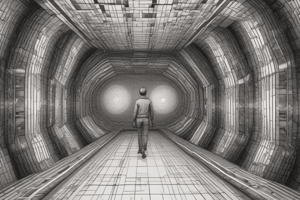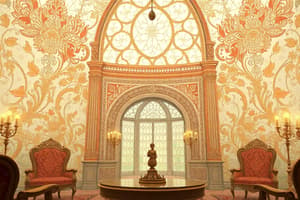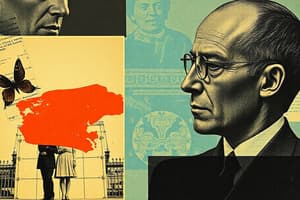Podcast
Questions and Answers
What is the primary goal of perceptual organization?
What is the primary goal of perceptual organization?
- Visual attention
- Organizing visual information into meaningful units or objects (correct)
- Object recognition
- Scene understanding
Which of the following is NOT a factor influencing object recognition?
Which of the following is NOT a factor influencing object recognition?
- Viewpoint
- Sound (correct)
- Lighting
- Context
What drives top-down visual attention?
What drives top-down visual attention?
- Visual features
- Object recognition
- Stimulus-driven factors
- Goal-driven factors (correct)
According to the Gestalt principles of grouping, which principle states that elements forming a continuous pattern are grouped together?
According to the Gestalt principles of grouping, which principle states that elements forming a continuous pattern are grouped together?
What is the main difference between bottom-up and top-down visual attention?
What is the main difference between bottom-up and top-down visual attention?
Which of the following is an example of figure-ground segregation?
Which of the following is an example of figure-ground segregation?
What is the primary function of scene understanding in everyday life?
What is the primary function of scene understanding in everyday life?
Which principle of segregation states that objects with similar features are more likely to be grouped together?
Which principle of segregation states that objects with similar features are more likely to be grouped together?
What influences scene understanding, according to the challenges of scene understanding?
What influences scene understanding, according to the challenges of scene understanding?
What is the process of separating objects from the background and each other in a visual scene?
What is the process of separating objects from the background and each other in a visual scene?
Which principle of segregation states that objects with continuous boundaries are more likely to be perceived as a single unit?
Which principle of segregation states that objects with continuous boundaries are more likely to be perceived as a single unit?
What type of processing involves feature extraction and grouping based on local features?
What type of processing involves feature extraction and grouping based on local features?
What is a major challenge for computers in object recognition due to variability in object appearance?
What is a major challenge for computers in object recognition due to variability in object appearance?
Which of the following is a challenge in scene understanding for computers?
Which of the following is a challenge in scene understanding for computers?
What is a challenge for computers in recognizing objects due to intra-class variability?
What is a challenge for computers in recognizing objects due to intra-class variability?
What is a challenge for computers in scene understanding due to scene complexity?
What is a challenge for computers in scene understanding due to scene complexity?
What is a challenge for computers in object and scene perception due to sensory limitations?
What is a challenge for computers in object and scene perception due to sensory limitations?
What is a challenge for computers in object and scene perception due to lack of common sense?
What is a challenge for computers in object and scene perception due to lack of common sense?
What is a challenge in scene understanding for computers due to ambiguity and uncertainty?
What is a challenge in scene understanding for computers due to ambiguity and uncertainty?
What is a challenge in object recognition for computers due to occlusion and clutter?
What is a challenge in object recognition for computers due to occlusion and clutter?
Flashcards are hidden until you start studying
Study Notes
Object and Scene Perception
Perceptual Organization
- The process of organizing visual information into meaningful units or objects
- Involves grouping, segmentation, and figure-ground segregation
- Important for object recognition and scene understanding
Object Recognition
- The process of identifying and categorizing objects based on visual features
- Involves feature extraction, object representation, and matching to stored representations
- Can be influenced by factors such as viewpoint, lighting, and context
Visual Attention
- The selective focusing of processing resources on certain aspects of the visual environment
- Can be driven by bottom-up (stimulus-driven) or top-down (goal-driven) factors
- Important for efficient processing of complex visual scenes
Gestalt Principles of Grouping
- Principles describing how visual elements are organized into groups or objects
- Proximity: elements near each other are grouped together
- Similarity: similar elements are grouped together
- Continuity: elements forming a continuous pattern are grouped together
- Closure: elements forming a closed shape are grouped together
- Figure-Ground: elements in the foreground are grouped together, separate from the background
- Common Fate: elements moving together are grouped together
- Good Continuation: elements forming a continuous pattern are grouped together
Object and Scene Perception
Perceptual Organization
- Organizes visual information into meaningful units or objects through grouping, segmentation, and figure-ground segregation
- Essential for object recognition and scene understanding
Object Recognition
- Identifies and categorizes objects based on visual features, involving feature extraction, object representation, and matching to stored representations
- Influenced by factors such as viewpoint, lighting, and context, affecting recognition accuracy
Visual Attention
- Selectively focuses processing resources on certain aspects of the visual environment
- Driven by either bottom-up (stimulus-driven) or top-down (goal-driven) factors, influencing what we attend to
Gestalt Principles of Grouping
Proximity
- Elements near each other are grouped together, forming a unified perception
Similarity
- Similar elements are grouped together, based on shared characteristics
Continuity
- Elements forming a continuous pattern are grouped together, creating a cohesive whole
Closure
- Elements forming a closed shape are grouped together, completing an incomplete shape
Figure-Ground
- Elements in the foreground are grouped together, separate from the background, creating a clear distinction
Common Fate
- Elements moving together are grouped together, due to their shared motion
Good Continuation
- Elements forming a continuous pattern are grouped together, creating a smooth and coherent perception
Scene Understanding
- Scene understanding is the ability to perceive and understand the layout, objects, and relationships within a visual scene.
- It's crucial for everyday activities, such as navigating environments, recognizing objects, and understanding events.
- Scene understanding faces challenges, including:
- Complexity: Scenes can be cluttered, noisy, and dynamic.
- Ambiguity: Objects can be partially occluded, rotated, or viewed from unusual angles.
- Contextual influence: Scene understanding is influenced by prior knowledge, attention, and expectations.
Principles of Segregation
- Segregation is the process of separating objects from the background and each other in a visual scene.
- The principles of segregation include:
- Proximity: Objects close together are more likely to be grouped together.
- Similarity: Objects with similar features (e.g., color, shape) are more likely to be grouped together.
- Continuity: Objects with continuous boundaries are more likely to be perceived as a single unit.
- Closure: The tendency to complete incomplete shapes or boundaries.
- Common fate: Objects moving together are more likely to be perceived as a single unit.
- Good continuation: The tendency to perceive smooth, continuous curves rather than abrupt changes.
- Past experience: Prior knowledge and expectations influence segregation.
- Segregation involves both bottom-up and top-down processing:
- Bottom-up processing: Feature extraction and grouping based on local features (e.g., edges, colors).
- Top-down processing: Higher-level knowledge and expectations influence feature extraction and grouping.
Object Recognition Challenges
- Objects can appear differently due to variability in lighting conditions, viewpoints, and contexts, making recognition difficult for computers.
- Partial occlusion and clutter can make object recognition challenging, as computers need to separate objects from the background and other objects.
- Intra-class variability, where objects within the same class have distinct features, requires computers to learn to generalize across these variations.
Scene Understanding Challenges
- Contextual understanding is essential for computers to recognize objects, as objects are related to each other and the scene's overall context.
- Scene complexity, with many objects, requires computers to prioritize objects and allocate resources efficiently.
- Ambiguity and uncertainty in scenes, with multiple possible interpretations, require computers to handle uncertainty and make probabilistic predictions.
Additional Challenges
- Computer vision systems are limited by the quality and type of sensors used, which may not capture all the necessary information for accurate object and scene perception.
- Computers lack real-world experience and common sense, making it difficult to program them with the same level of understanding and intuition as humans.
Studying That Suits You
Use AI to generate personalized quizzes and flashcards to suit your learning preferences.




